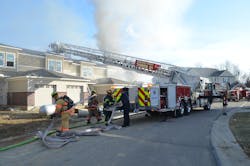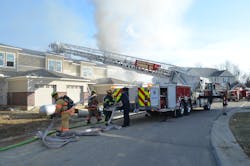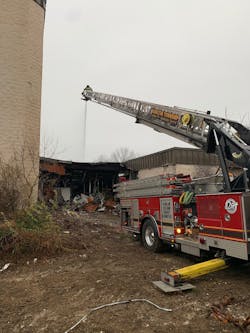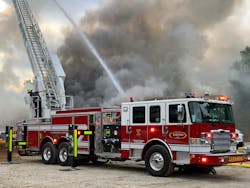Tips for Determining Aerial Apparatus Outrigger Type
While conducting your needs analysis for aerial apparatus, you must determine the outrigger type, configuration and quantity that will work within your community. As with aerial construction, outrigger types vary greatly across the industry.
The three most common outrigger types are A-frame, H-style and under-slung jacks. Tormentors and downriggers also are prevalent, particularly with mid-mount aerial devices. Each has its pros and cons, and it’s up to the purchaser to determine what will be the best fit for the running area of the apparatus.
The outrigger’s shoe, jack penetration and short-jacking capabilities also are specification items that require attention by the purchasing committee.
The options
A-frame jacks are out-and-down jacks that usually only protrude a couple of feet from the side of the apparatus. They can be utilized as the sole stabilization system for the aerial or in conjunction with another style of stabilizer. These jacks are fast to deploy and take up very little space on the fireground. Although they are most common in smaller aerial devices, such as elevated waterway booms and articulating platforms, they also are utilized on tractor-drawn aerials that have lighter tip loads and often in conjunction at the front of the apparatus with rear H-style jacks.
The major disadvantage of A-frame outriggers is that they have limited application for aerials that have longer reaches when they aren’t used in conjunction with other types of outriggers.
H-style jacks are perhaps the most commonly utilized jacking system in the fire service for mid-mount and rear-mount aerial apparatus. Depending on your department’s aerial type, length and tip weight, you can specify H-style jacks in two- and four-jack configurations.
The industry also varies greatly in the extended footprint of H-style jacks, which currently is from 12–19 feet or greater. In four-jack configurations, larger outrigger footprints can take up valuable real estate on the fireground.
Jack-mounting locations also differ among apparatus manufacturers. Two-jack outrigger systems can be mounted mid-ship or aft of the rear wheels.
Under-slung jacks also are popular among apparatus manufacturers. These jacks have a lower center of gravity than the types of jacks have and allow for compartments to be situated above the jack in the body. Under-slung jacks are available in two- and four-jack configurations, depending on the type and length of the aerial device. These jacks can have as little as an 11-foot span when fully deployed and can be as long as 16 feet.
Under-slung jacks deploy extremely quickly and in a small footprint. This is perhaps their greatest advantage.
Note: Not all manufacturers allow users to short-jack under-slung jack systems. This can be problematic in areas that have tight developments.
Tormentors are mounted vertically mid-ship and fold down into their operating position, as utilized in the iconic Seagrave Aerialscope. These outriggers have an operating spread of as much as 20 feet, 6 inches for 95-foot models and are utilized in conjunction with downriggers to provide additional chassis stabilization.
The major advantage of utilizing the tormentor configuration: A tower ladder that includes it has uninhibited access over the front stabilization device for grade or below-grade operations. This capability makes it an invaluable resource on the fireground. A disadvantage of this configuration: Because the tormentor must pivot down into its operating position, if you must short-jack the apparatus, you can’t get the short-jacked side on the ground, unlike with other outrigger types.
Lastly, downriggers are utilized in conjunction with other outrigger types and usually are mounted on the front bumper extension and/or aft of the rear duals. As the name implies, downriggers protrude straight down from the apparatus to provide chassis stabilization by capturing the vehicle’s suspension. Downriggers are utilized most commonly on mid-mount aerial devices; however, they are becoming popular on rear-mount aerial apparatus, too. Some manufacturers utilize downriggers instead of A-frame stabilizers at the front of rear-mount aerial devices when used in conjunction with other outrigger types.
A major advantage of utilizing downriggers with other outrigger types is that downriggers don’t take up additional real estate on the fireground. A disadvantage is that they can take up valuable front bumper and compartment storage.
Shoes
The shoe of the aerial jack is another option that must be considered. Jack shoes vary greatly among manufacturers and have a direct correlation for the need to place a jack stabilizer pad under each outrigger, which takes time. Some manufacturers offer built-in stabilizer pads to the outrigger shoe to completely eliminate the need for a separate outrigger jack stabilizer pad.
Although NFPA 1901: Standard for Automotive Fire Apparatus indicates that the ground contact area for each stabilizer “shall be such that a unit pressure of not greater than 75 psi (500 kPa) will be exerted over the ground contact area when the apparatus is loaded to its maximum in-service weight and the aerial device is carrying its rated capacity in every position permitted by the manufacturer,” it also notes that “a stabilizer pad can be utilized to achieve 75 psi (500 kPa) or less.”
Jack penetration is yet another critical consideration for communities that have extreme topography. Manufacturers typically offer several different options for jack penetration to allow you to level the turntable within usable limits while on grade. Several manufacturers offer deep-penetrating jacks that can allow for more than 10 degrees of leveling both front-to-rear and side-to-side. A disadvantage of deep-penetrating H-style jacks is that you likely will lose the capability to have any compartments above the outrigger. In many communities, it’s found that this is a necessary tradeoff.
The capability to short-jack an aerial apparatus off of the nonworking side can reduce the real estate that the vehicle utilizes on the fireground. It also might be essential in tighter developments or for later-arriving aerial apparatus. Often, you must pull the aerial apparatus as far across the street as possible to drop the base section of the aerial to lower floors. Many 100-foot rear-mount aerials have a retracted boom length of 34 feet or more off of the side. Short-jacking the nonworking side increases the scrub area of aerial ladders and tower ladders.
Not all jacking systems can be short-jacked, so it’s important that you know the apparatus’ running district to see what will work for you. Additionally, some short-jack systems require two personnel to get the main aerial out of the bed of the vehicle. This can be problematic on a fire scene where personnel are going about the completion of their assigned task. To increase efficiency, you can specify single-person short-jack capabilities.
About the Author

Mark Miller
Mark Miller is a 26-year veteran of the fire service and currently is a deputy fire chief in Southwest Ohio. He holds a master’s degree in public safety administration, the Executive Fire Officer designation from the National Fire Academy and the Chief Fire Officer designation through the Center for Public Safety Excellence. Miller routinely speaks on fire apparatus positioning on the fireground and conducting an apparatus needs analysis.




